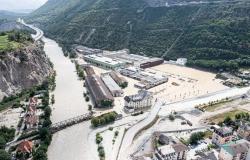The development of vegetation has never been as early as this year. Has the expression “there are no more seasons” come true?
Posted today at 8:08 a.m.
Subscribe now and enjoy the audio playback feature.
BotTalk
Seasons according to plants
There is one thing that almost certainly reveals our position in the annual cycle of the seasons. Without even having to endure the stifling heat of a scorching summer or the cold of winter, a quick glance through the window rarely fails to tell us about the current month.
Because flora is the undeniable marker of the seasons: influenced by astronomical, climatic and meteorological conditions, plants transform according to the calendar according to biological processes whose subtlety is still poorly understood.
However, the timing of the transition between the different stages of plant development can vary enormously from one year to the next. To the point of sometimes making us lose our bearings. These changes are obvious if we look at the historical records of our chestnut tree.
Dormancy and growth
Switzerland has been studying the development of its vegetation since the 1950s. Greening, flowering, leaf fall and other seasonal behaviors are carefully observed and recorded by the Federal Office of Meteorology and Climatology (MétéoSuisse). This research is called phenology.
“Our network has 160 stations,” says Regula Gehrig, climatologist at MétéoSuisse and vice-president of the Swiss commission for phenology and seasonality. Some of our observers have been monitoring the same plants for over forty years.”
Unlike the astronomical seasons – those of our calendar – the phenological periods are not determined by fixed dates, but follow the cycles of nature. Snowdrops mark the start of spring, the flowering of the lime tree and the chestnut tree indicate the start of summer and the ripening of black elderberries announces autumn.
The details of the biological processes that plunge plants into a state of dormancy, to protect themselves from the cold of winter, or trigger the emergence of buds, are still poorly understood. Many factors come into play: humidity, soil quality, day length and above all, temperature.
The disappearance of the seasons
According to a study from the University of Colorado at Boulder, the tropics expand by a few tenths of a degree of latitude every ten years. Global warming is believed to be responsible for this expansion of the equatorial climate, depriving certain regions, which formerly had four seasons, of spring and autumn.
Switzerland is not there yet. However, if we consider the phenological spring as the marker of the return of sunny days, then the spring-summer period is undeniably lengthening. Year after year, the plants wake up and scrounge off a few days in winter. “The lengthening of this phase of the year is above all the result of an increasingly early spring,” explains Regula Gehrig.
In Switzerland, despite the strong warming, winters are still cool enough to allow a normal reaction of leaf development and flowering: in other words, the warmer the winter and spring, the earlier the vegetation starts. However, the warming trend risks masking this gap. “A lack of cold in winter can also delay budburst (editor’s note: the moment when the buds develop), underlines Regula Gehrig. This is not yet the case in our country, but we can see it in southern Europe, such as in Spain. This will perhaps also be the norm in Switzerland in two or three decades.”
In the meantime, MeteoSwiss observations still allow us to detect a discrepancy in the measurements. If the differences between the phases of plant development are no more pronounced today than twenty-five or fifty years ago, the appearance of flowers is always earlier. To understand this better, we calculated the average flowering date, in periods of twenty-five years, of plants which have long observation series.
A hint for spring
Phenological spring is so important to seasonal research that it has a clue in its name. Calculated on the basis of different stages of development of a selection of trees and flowers, it highlights the effects of climate change on vegetation. It also facilitates the creation of models that will make it possible to predict future developments and trends.
The spring index integrates observations from nearly 80 stations in the Swiss phenological monitoring network. It measures the difference in days of the vegetation development phase in Switzerland compared to the average for the period 1991-2020. This reference period is defined every ten years by the World Meteorological Organization. It allows us to compare the current climate with past periods.
An early spring could delight more than one person. However, a winter that is too mild is also synonymous with a bad harvest: the mechanism which should bring the plant out of its dormancy becomes confused and it remains asleep. “If the winter is not cold enough, then the flowering is less intense,” explains Régula Gehrig. We observed this in Tunisia, in pistachio crops. The production of these fruits is less important after mild winters.
Early blooming also puts fruit tree flowers at risk of freezing when temperatures drop. “Thirty or forty years ago, the vines began to develop during the first half of April,” explains Vincent Devantay, meteorologist at MétéoNews. This year, it started to bud from mid-March.” All it takes is a cold snap, usual during this time of year, to do a lot of damage.
Climate dice
In the 1980s, James Hansen, an American climatologist, suggested thinking of climate as a pair of dice: each side should have an equal chance of appearing after a roll. But with global warming, the likelihood of falling on faces that correspond to extreme weather events increases. According to the researcher, from a certain number of rolls, we should realize that the dice are rigged.
James Hansen believed this awareness would increase awareness of climate change. In Switzerland, it is perhaps the plants which reveal to us that the climate dice are loaded.
Note: The days presented in the graphs are calculated without taking into account leap years.
“Latest news”
Want to stay on top of the news? “Tribune de Genève” offers you two meetings per day, directly in your email box. So you don’t miss anything that’s happening in your canton, in Switzerland or around the world.To log in
Did you find an error? Please report it to us.
5 comments






